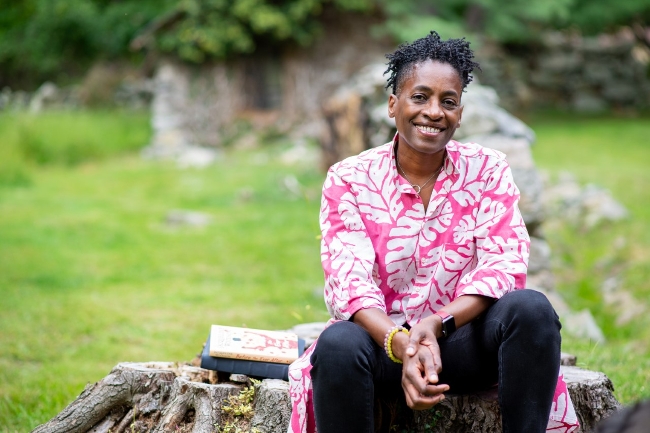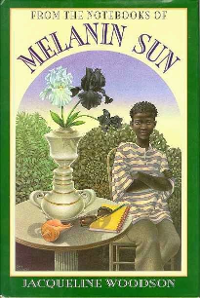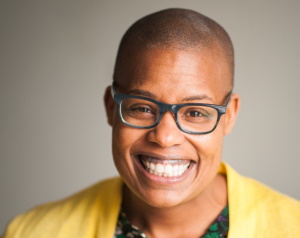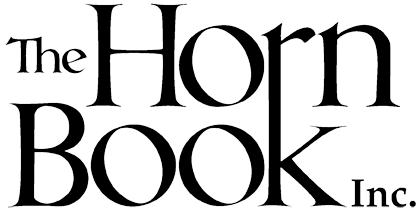An Interview with MacArthur Fellow Jacqueline Woodson
On October 19, 2020, Horn Book executive editor Elissa Gershowitz and Horn Book reviewers and contributors Monique Harris, Nicholl Denice Montgomery, and Dr. Kim Parker had a phone conversation with newly named MacArthur Fellow Jacqueline Woodson.
On October 19, 2020, Horn Book executive editor Elissa Gershowitz and Horn Book reviewers and contributors Monique Harris, Nicholl Denice Montgomery, and Dr. Kim Parker had a phone conversation with newly named MacArthur Fellow Jacqueline Woodson. Huge thanks to Moné Dixon, assistant to Jacqueline Woodson, and Edelman representative Amaya Starkey, for the MacArthur Foundation.

Jacqueline Woodson. Photo: The John D. and Catherine T. MacArthur Foundation.
Elissa Gershowitz: Congratulations on being named a 2020 MacArthur Fellow! We’re so happy to be talking to you. I’d like to ask about “the call.” With the ALA awards, if your phone rings on a certain day in January, maybe you know what it is. How did it happen with this?
Jacqueline Woodson: I think they had started calling the day before. It was a Chicago number, and I very rarely answer my phone if I don’t know who’s calling me. It was weird, because that night I had been reading Ghosts in the Schoolyard, Eve Ewing’s work set in Chicago, and I just adore her—so I was thinking about Eve Ewing, and when I saw the Chicago number, I was like, oh, maybe Eve’s calling me, maybe I’m a little bit psychic. So when I picked up the phone and Cecilia Conrad [Managing Director, MacArthur Fellows] said, “This is Cecilia calling from the MacArthur Foundation,” I literally just dropped into my seat, because I knew immediately what it was. Everybody knows someone who’s gotten one in my circle, but I had no idea. I remember people telling me they got the call in July, and they had to keep it secret till the fall. This call came in August, so it felt very much out of the blue. I think the only thing I can compare it to is the Astrid Lindgren call, which came at five in the morning, and I didn’t even know that it was an award given to Americans. It’s true with ALA, you know when ALA meets. But this took me by complete surprise.
EG: And your cohort is so amazing too. It’s such a great year, a great group. I was looking back through all the children’s lit people who have won, which are not that many, and that cohort is amazing too.
JW: Who was it besides Angela [Johnson] and Virginia [Hamilton]?
EG: Gene Luen Yang won a few years ago. Sandra Cisneros, David Macaulay, Karen Hesse, Peter Sis. A few others who have since written children’s books. It’s a small group. I have to tell you—this group of us talked for about three hours over the weekend in preparation for this call.
JW: Nothing you can ask me is wrong; I just want to put that out there.
Monique Harris: I know the grant is really new, but what do you think it will allow you to do in this space and time, for your work and your life?
JW: It’s a continuation of the Lindgren award, in that when I won that, I bought property in Brewster, New York. (I still live in Brooklyn.) The plan was to build Baldwin for the Arts, which is a residency for BIPOC artists—writers, composers, visual artists. We’ve renovated one property, and have had a bunch of writers come through there. Now we’re going to start renovating and building studios for other artists, and for me. This is where the money’s going, to build this space for other artists. It’s kind of been a dream of mine since the first time I went to MacDowell, the residency in New Hampshire, and saw what someone giving you space and time and three meals a day, at no cost, allows to happen. And Cave Canem—I watched Cave Canem get built from the idea that Cornelius Eady and Toi Derricotte had, to become this space that changed the narrative of poetry in this country and beyond. So many more National Book Awards, so many more awards in general, and so many more poets of color getting visibility. I want to see that happen with other artists.
Kim Parker: That’s incredible. And Jackie, your enduring love for other folks has been a powerful through-line in all of your work, so this just makes sense. I’m so happy that you have the funds to make this a reality. I think about all the other people who are coming after who are going to benefit from this. It’s just wonderful. I love it.
JW: Thank you. I’m so excited to see it happen. I’m not going to be here forever. To watch it live on, and to know that it’s something that can continue—the reason I’m here is because of Virginia Hamilton and writers who came before me who helped me get to this place.
EG: You’re such a mentor for people. Who are you excited to be reading now and seeing come up after you? And who were those literary mentor figures for you?
 JW: The mentor figures for me, starting very early, of course, John Steptoe, Virginia Hamilton, Walter Dean Myers, the Dillons, the McKissacks—those were all people who were there basically saying, “We got you.” When I wrote From the Notebooks of Melanin Sun, which was Scholastic’s first book to deal with queer narrative, Virginia blurbed it. In the late eighties and through the nineties, Rita Williams-Garcia and I were coming up, and some other writers. It felt like there was this community to welcome us, saying, “Yeah, this is a party you’re invited to. Please, please come in.” And now, Candice Iloh, who wrote Every Body Looking, and Kacen Callender are two of the writers I can think of off the bat who I’m really excited about, pushing against the boundaries of what children’s literature can be. Kaitlyn Greenidge is another writer I really love. She’s basically writing adult stuff, but I expect her at some point to write for young people. Brit Bennett. I don’t read as much as I’d like to—I’m usually working on a book. Now I’m working on a screenplay about Ida B. Wells, so I’m reading everything that was ever written about Ida B. Wells, so that’s where my head is. But there is interesting stuff happening that I’m going to wrap my head around at some point.
JW: The mentor figures for me, starting very early, of course, John Steptoe, Virginia Hamilton, Walter Dean Myers, the Dillons, the McKissacks—those were all people who were there basically saying, “We got you.” When I wrote From the Notebooks of Melanin Sun, which was Scholastic’s first book to deal with queer narrative, Virginia blurbed it. In the late eighties and through the nineties, Rita Williams-Garcia and I were coming up, and some other writers. It felt like there was this community to welcome us, saying, “Yeah, this is a party you’re invited to. Please, please come in.” And now, Candice Iloh, who wrote Every Body Looking, and Kacen Callender are two of the writers I can think of off the bat who I’m really excited about, pushing against the boundaries of what children’s literature can be. Kaitlyn Greenidge is another writer I really love. She’s basically writing adult stuff, but I expect her at some point to write for young people. Brit Bennett. I don’t read as much as I’d like to—I’m usually working on a book. Now I’m working on a screenplay about Ida B. Wells, so I’m reading everything that was ever written about Ida B. Wells, so that’s where my head is. But there is interesting stuff happening that I’m going to wrap my head around at some point.
EG: You’re working on your screenplay—do you work on all your projects at once, or do you finish one project and then start the next? Are you able to keep all that in your head and hands at the same time?
JW: I work on many projects at once. I do try to be a little organized about it. I have folders: this is the Ida B. Wells screenplay, this was Red at the Bone, this is the new book I’m working on. But I’m not always good about that. Sometimes I’ll find papers mixed together from, say, a picture book and a screenplay because I’ll have the different projects on my desk and go from project to project. But I can kind of change the channel of my brain to work on something different.
KP: Do you think that this moment—with the work you’ve done, the new authors, the authors who are finally getting some recognition—is changing the children’s book industry? I look ahead and wonder if we’re going to continue to see more books published by Black writers for young people. Is this a moment? What do you think will happen? And what would you like to happen?
JW: I would like for it to be more than a moment. The thing about children’s book publishing is it’s a business. The moment will last as long as the books sell. The way they sell is by getting awards and good reviews and by being adopted into classrooms and bought by libraries. Given the energy of this country and the revolutionary moment we’re living in, people are becoming more conscious of the need to have classroom libraries that reflect not only the students who are in them, but the students who their students might never meet as well. But I do think there has to be a demand for it, and what I’ve seen is that sometimes people don’t know how to find the books. “Here’s a list from 1980. Here’s a ‘diverse’ list.” So I think the work of figuring out how to get the books that are relevant, including backlist—the fiction that was published in the nineties, there’s stuff that’s important that people have in their classrooms, but as long as these new writers keep getting held up and seen, then we can begin to change this narrative. Across the country, no one wants an all-white collection of books anymore. They know that that’s not the right thing to have. And publishers know that people are looking for are books by diverse voices. I think we are moving the needle. I think things are going to change. We’re not going to go back to the way it was before. But it’s going to be interesting to see what it becomes.
KP: I agree. I can’t wait. I am really excited to see what’s happening. There’s such great stuff. And also, I appreciate what you said about the back catalogues being so extensive, and what I’ve realized from working with teachers and other folks is that there are so many books they don’t even know. It’s great that Nicholl is doing her research—early Jackie Woodson through now is quite expansive. I can’t wait to read her paper, because thinking about just your own evolution is so powerful.
JW: Oh, man. It gets a little raggedy early on.
Nicholl Denice Montgomery: Working on my dissertation about your body of work, I’ve read all of your stuff from the nineties so far—I’m up to the mid-2000s. All of it is beautiful. I sit here with tears streaming. “Why are you crying?” “I just finished another Jacqueline Woodson book.” For me, as somebody who writes, as somebody who reads, I always wonder How did she do that? There’s such simplicity, and it’s so powerful. What do you do in your process to get those perfect words on the page?
 JW: I appreciate you, and I appreciate the work you’re doing, so thank you for the question. You have to feel it. I think that’s a key about writing. You can’t be afraid to be in your feelings. When the writing is really painful, a writer has to feel that pain. When it’s really heartbreaking, you have to feel that heartbreak. When it’s really joyous, you have to be in that moment of joy. The psychological part of writing is a challenge. No one wants to sit there and feel that pain of a heartbreak again, but it’s really letting yourself be exposed to the moment in the narrative, as opposed to being outside of it, just writing it. I look at something like I Hadn’t Meant to Tell You This, which I wrote how many decades ago, and I can still feel the moment of Marie breaking Lena’s heart with a couple of words. It’s the moment when they’re in the cafeteria, and the friend goes, “She’s white trash,” and Lena goes, “I’m white trash,” and it settles into her that that’s how the world is seeing her. That’s a heartbreaking moment for a twelve-year-old, to realize that she is being seen by the world in this way that she never knew before. She just thought she was a human walking through the world. I remember going back and writing that and just having to sit for a while, and be like, “Damn. This world is a mess.” And I’m not thinking, Okay, Jackie, you created that moment, it doesn’t really exist. Because it does exist. That complexity. And reading it out loud and writing it and really hearing even the breath of the character as she’s saying “I’m white trash” makes that moment truly live on the page.
JW: I appreciate you, and I appreciate the work you’re doing, so thank you for the question. You have to feel it. I think that’s a key about writing. You can’t be afraid to be in your feelings. When the writing is really painful, a writer has to feel that pain. When it’s really heartbreaking, you have to feel that heartbreak. When it’s really joyous, you have to be in that moment of joy. The psychological part of writing is a challenge. No one wants to sit there and feel that pain of a heartbreak again, but it’s really letting yourself be exposed to the moment in the narrative, as opposed to being outside of it, just writing it. I look at something like I Hadn’t Meant to Tell You This, which I wrote how many decades ago, and I can still feel the moment of Marie breaking Lena’s heart with a couple of words. It’s the moment when they’re in the cafeteria, and the friend goes, “She’s white trash,” and Lena goes, “I’m white trash,” and it settles into her that that’s how the world is seeing her. That’s a heartbreaking moment for a twelve-year-old, to realize that she is being seen by the world in this way that she never knew before. She just thought she was a human walking through the world. I remember going back and writing that and just having to sit for a while, and be like, “Damn. This world is a mess.” And I’m not thinking, Okay, Jackie, you created that moment, it doesn’t really exist. Because it does exist. That complexity. And reading it out loud and writing it and really hearing even the breath of the character as she’s saying “I’m white trash” makes that moment truly live on the page.
NDM: That one, and Lena broke my heart. I had to put it down for a while. In so many of the books—like you said, you feel the person sitting with you. I felt like Lena was sitting here. I think I hugged the pillow, like “Lena, come here.” People do come alive on the page, and it’s just so beautiful. Before the Ever After—it’s such a love song to his father. Thank you for writing. Thank you for giving me a thesis project that’s worth doing! I get to sit here with Jacqueline Woodson’s work. I just hope I get it right.
JW: Thank you. You will get it right.
KP: I love the intergenerational nature of your work. I was just thinking about the books and characters who have stuck with me the most. I’ve done lots of work with Black boys—Locomotion and Miracle’s Boys are the ones that stay with me. I’m reading Before the Ever After with my son now, who is very into it. We read it at night and we talk about it. It’s the nice complexity of your work that makes it resonate with so many different readers. I appreciate that, and I also wonder, when you set out to write these books, do you think about these levels of readership? Because your books invite multiple readings, and you can say to young people, “This book is going to deepen as you go back to it again and again.”
JW: Oh, man. Thanks so much for reading them that way. That’s always been my hope, because that’s how I read. Each time I would go back to a book, I’d get something else. How did I miss that before? And as I got older, I understood stuff at a deeper level.
When I’m writing, the way I’m thinking about the reader is only in terms of: Will this be hurtful to someone? Is this representation okay? When I was writing Miracle’s Boys—there’s a scene with Charlie and his little brother, Lafayette, who’s karate chopping, and he’s like, I want to be like Jackie Chan. The scene ended there, and I remembered having my friend Katherine Gunn read it, and she said, “You realize this is the only representation of Asian people you have in the book, and it’s a stereotype.” And she’s a white woman. I went back and looked at that scene, and completely changed it. I didn’t want people coming to the book to think that stereotype is something I condone being reinforced; and especially for Asian readers, I don’t want them to see this representation. So I went back and wrote this whole part, with his brother saying, That’s a stereotype, like when people say all Black folks are lazy, and explaining what a stereotype is.
 And with something like Each Kindness, I think about kids who are coming to that book and seeing themselves in Maya, and in that respect, I’m not going to make Maya this victim, because I don’t want people who are in those conditions to think of themselves as victims. That’s why the two times you see Maya engage—the first time no one plays jacks with her, and she doesn’t stop playing; she comes into the classroom, and she’s like, I bet you can’t guess who the jacks champion of the world is. That moment of her saying Y’all aren’t going to stop me. And then the last time we see her, she rolls the rope around her hands and jumps around the whole schoolyard without stopping. She didn’t look up once, just jump, jump, jump. And she jumps right off the page. She jumps right out of the narrative. But that last moment we see her is in this position of power. She’s like, If you biddies don’t want to play with me, I’m going to jump by myself. And Chloe’s watching this like, Oh shoot. She’s kind of badass, right? We’re not stopping her. It’s the other girls who are losing out, and that’s the moment when Chloe realizes it, but that moment is too late. But for the reader, I do want them to look at Maya and see—if this person is like me, I, too, will not be stopped by the cruelty of others.
And with something like Each Kindness, I think about kids who are coming to that book and seeing themselves in Maya, and in that respect, I’m not going to make Maya this victim, because I don’t want people who are in those conditions to think of themselves as victims. That’s why the two times you see Maya engage—the first time no one plays jacks with her, and she doesn’t stop playing; she comes into the classroom, and she’s like, I bet you can’t guess who the jacks champion of the world is. That moment of her saying Y’all aren’t going to stop me. And then the last time we see her, she rolls the rope around her hands and jumps around the whole schoolyard without stopping. She didn’t look up once, just jump, jump, jump. And she jumps right off the page. She jumps right out of the narrative. But that last moment we see her is in this position of power. She’s like, If you biddies don’t want to play with me, I’m going to jump by myself. And Chloe’s watching this like, Oh shoot. She’s kind of badass, right? We’re not stopping her. It’s the other girls who are losing out, and that’s the moment when Chloe realizes it, but that moment is too late. But for the reader, I do want them to look at Maya and see—if this person is like me, I, too, will not be stopped by the cruelty of others.
MH: Harbor Me is one of my favorite books. It has not gotten the acclaim that it absolutely should. Every schoolchild should be reading that book.
KP: Particularly right now.
MH: It’s so beautifully written, how empowered the children in that class are. They are all in such vulnerable places in their personal lives, and also in their school lives. They are the castaways, and they create this beautiful community. They are so empathetic to one another. They’re cheering for one another! You write children into the world who are very self-aware, and as adults we often don’t see children as being able to solve their own problems, or to be the fully realized, empathetic beings they can be.
 JW: Thank you. I love those kids, and I love their teacher, who truly sees them. That’s so much what young people need, the adults who see them and can understand how to help them move forward. And the fact that as adults, sometimes we just have to get the heck out of the way. I started writing that book some years ago, because what’s happening with immigrants is not new. What’s happening with Black boys is not new. What’s happening with mass incarceration is not new. But I hadn’t been able to have a literary conversation about it with young people. As I was writing Harbor Me, I was like, “I don’t know what this book is, I don’t know what it’s trying to say, I don’t know why there’s so many protagonists.” And as it started coming together, it made sense. This is about young people being able to open up about their lives, and how they do see each other and do need that space of being able to be honest. Sometimes our own self-protection doesn’t allow for that, because they see ways in which we don’t feel comfortable around them. It was an interesting book to write, because I had to learn so much about myself as not only a writer, but as a mom. Let me get out of my kids’ way.
JW: Thank you. I love those kids, and I love their teacher, who truly sees them. That’s so much what young people need, the adults who see them and can understand how to help them move forward. And the fact that as adults, sometimes we just have to get the heck out of the way. I started writing that book some years ago, because what’s happening with immigrants is not new. What’s happening with Black boys is not new. What’s happening with mass incarceration is not new. But I hadn’t been able to have a literary conversation about it with young people. As I was writing Harbor Me, I was like, “I don’t know what this book is, I don’t know what it’s trying to say, I don’t know why there’s so many protagonists.” And as it started coming together, it made sense. This is about young people being able to open up about their lives, and how they do see each other and do need that space of being able to be honest. Sometimes our own self-protection doesn’t allow for that, because they see ways in which we don’t feel comfortable around them. It was an interesting book to write, because I had to learn so much about myself as not only a writer, but as a mom. Let me get out of my kids’ way.
KP: I listened to the audio, and I think one of your children is narrating, right?
JW: Yeah, my daughter Toshi. And then at the end my son and I have a conversation, which is actually my favorite part of the audio. When he found out Toshi was doing it, he said, “Is there anything I can do?” And I said, “Let’s get in a room and talk at the end.” And he surprised me. He’s like, “Some people have two moms, but what about nonbinary?” I’m like, “You go! We did good here.”
KP: My son and I stayed in the car to listen till the end. He was very, very taken with it.
JW: How old is your son?
KP: He’s six now, Jackie. I think you met him—held him, even—when he was one or two. He was little.
JW: Oh my goodness. This is so amazing. You’re amazing.
KP: Now he’s being raised on the words of Jacqueline Woodson. I think he’s going to be just fine.
EG: When we were talking earlier, it really struck us that even in the books where there is some big narrative event, the stories are so often about the characters, and how the characters and the community are reacting to the big event. It’s not this spotlight on police violence, or spotlight on immigration. Something might happen, and then here are the ways that affects the people around the issue.
JW: That’s true. Outsiders might look at the big event, without looking at its impact on individuals. When I was writing Red at the Bone that was one of the things I was thinking about for the character Aubrey, who was in the World Trade Center. Sometimes when people think about that tragedy, they might forget about the individuals who died. Somebody’s dad, somebody’s brother, somebody’s son. I wanted to magnify that, and say here is a really good person, and we lost them.
MH: I also love how you weave in the history of the Tulsa massacre. It was really subtle, but central in the book. That community, even though it was dissolved, they still had a very protective—they went underground and protected themselves, kind of insular. I loved every bit of it.
 JW: Thank you. Yeah, 2021 is the hundredth anniversary of the Tulsa Race Massacre, which for me is so surprising, in that I didn’t learn about it until I was in my twenties. And then in doing the research and seeing so many more places where that has happened.
JW: Thank you. Yeah, 2021 is the hundredth anniversary of the Tulsa Race Massacre, which for me is so surprising, in that I didn’t learn about it until I was in my twenties. And then in doing the research and seeing so many more places where that has happened.
EG: Educators in this group, what about that underlying issue of education—what people are learning and what are they not learning? How do you see these books either enriching the conversation, or even just being the first introduction someone might have to these events in history?
KP: I did my PhD with Violet Harris. She knew Jackie’s work. She knew Rudine Sims Bishop. So that was what we talked about. That was our canon. When you’re socialized into excellent Black literature in the way I was mentored into it by people like Violet and Jonda McNair, you have a way of understanding it and approaching it. And also now teaching teachers about it, that is really important. Monique just started her PhD--and the work that she and Nicholl are doing, which contributes to the scholarship, gives us a new way of understanding. We don’t have any academic text about your work, Jackie, and Nicholl is writing it. It’s a whole different conversation about academic scholarship and children’s literature and why it matters. We’re at this moment where we can do so much with it. And I think more and more people, because of the moment, are starting to use these texts, and to really understand that they are excellent and we should always be teaching them. We’ve missed the moment in some respects, because people are just now waking up, but the ones who are waking up have the capacity to use these books and have the access to them. That’s really, really promising and powerful.
 JW: That is awesome. I meet teachers coming out of programs that are usually PWIs, predominantly white institutions, and they have read The Other Side. “I love your book.” Singular. I hear that a lot. It blows me away—that’s the book some people are most comfortable teaching, because with the other stuff, you have to go into the weeds to talk about it. It is such a necessary work to enable people to have the conversations that I’d love for them to have around the book. Back before COVID, I was visiting a very white school, and one of the second-grade teachers said about Visiting Day: “I don’t share this book with my class, because I don’t want them to think that all Black men are in prison.” I was like, “Will they think that, or do you think that?” People are nervous about bringing their own prejudices to the classroom. Or sometimes they’re not nervous enough, and they do, and I’m like, “No, no, no, please don’t teach it that way.”
JW: That is awesome. I meet teachers coming out of programs that are usually PWIs, predominantly white institutions, and they have read The Other Side. “I love your book.” Singular. I hear that a lot. It blows me away—that’s the book some people are most comfortable teaching, because with the other stuff, you have to go into the weeds to talk about it. It is such a necessary work to enable people to have the conversations that I’d love for them to have around the book. Back before COVID, I was visiting a very white school, and one of the second-grade teachers said about Visiting Day: “I don’t share this book with my class, because I don’t want them to think that all Black men are in prison.” I was like, “Will they think that, or do you think that?” People are nervous about bringing their own prejudices to the classroom. Or sometimes they’re not nervous enough, and they do, and I’m like, “No, no, no, please don’t teach it that way.”
MH: I really believe the power is in empowering families around our texts and giving them an opportunity to have these deep conversations with children in their homes and their communities. I feel like the best angle at this point in time is helping families to create communities around books, which is our impetus for the family book club. What should we be reading, what can we read together, what can we talk about? How can we sustain our community around our stories and around the things that are important to us? Other people are going to mess it up, so we’ve just got to reinforce and lay the foundation for our children before they enter into the classroom. And we give them the tools to rebut things that aren’t true.
JW: Exactly.
NM: Thinking about This Is the Rope or I Hadn’t Meant to Tell You This—there are so many small towns across the United States where it used to be a mining town, it used to be this or that, and then that industry went away, and you’ve got the struggle between the Black and white folk where it had nothing to do with the Black people; it was the government playing games with these folks. We’ve got a whole history here that you could unpack with students. And I know that’s what you’re trying to do with your work, right, is have these conversations about race and how really this is not the people, but a larger system. If people sat down and talked to each other, they’d find out—I need a place to lay my head the same way that you do. We could just focus on your stories for the beauty of the writing—the dialogue, the imagery—but there are so many ways to teach it. “Let’s unpack this story and have a conversation about race, class, gender, and how they play with each other.” And like you said, nine times out of ten, it’s: “I just want to be a human being. I’m a human being full of emotions that people just don’t realize, because they don’t talk to me or they push me to the side.” There are so many levels—we could do book club forever just on Jacqueline Woodson!
KP: I am here for that! Black abundance. We have thirty years of Black excellence, right here.
JW: Oh my goodness, this is the best way to start my day.
MH: Well, you deserve it all!
KP: Jackie, and thank you for loving Black children. You always love them…
JW: Warts and all! These young people coming up are going to do it. I just throw up my hands—“Y’all got this.” We jacked up the environment, we jacked up the climate, we jacked up the government—they’re like, “You know what, sit down. We’ll take care of it. We’ve got our TikTok, we’ve got our IG.” When they had the walkout around school segregation—I don’t know how, but within twelve hours they had thousands of kids. I love how innovative they are. It’s fabulous—I truly, truly love them.
More from The Horn Book by and about Jacqueline Woodson, including her 2018 Children's Literature Legacy Award Speech, 2006 Zena Sutherland Lecture: "How Do I Come Home?", and 1998's "Who Can Tell My Story."
![]()

RELATED
ALREADY A SUBSCRIBER? LOG IN
We are currently offering this content for free. Sign up now to activate your personal profile, where you can save articles for future viewing.







Add Comment :-
Be the first reader to comment.
Comment Policy:
Comment should not be empty !!!